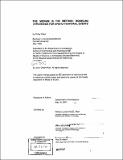| dc.contributor.advisor | William Lyman Porter and Mark Jarzombek. | en_US |
| dc.contributor.author | Khan, Omar, 1969- | en_US |
| dc.contributor.other | Massachusetts Institute of Technology. Dept. of Architecture. | en_US |
| dc.date.accessioned | 2011-12-09T21:20:24Z | |
| dc.date.available | 2011-12-09T21:20:24Z | |
| dc.date.copyright | 2001 | en_US |
| dc.date.issued | 2001 | en_US |
| dc.identifier.uri | http://hdl.handle.net/1721.1/67536 | |
| dc.description | Thesis (S.M.)--Massachusetts Institute of Technology, Dept. of Architecture, 2001. | en_US |
| dc.description | Includes bibliographical references (p. 121,123). | en_US |
| dc.description.abstract | In an increasingly networked environment, time has become synonymous with place. The amount of time allocated to an activity serves as the boundary between one space and another. So that where we once had places called home and work, now we have times that define that boundary. Within this context an architectural study of temporal events and the means of representing them is critical. What Is the architecture of a temporal event? How can one describe it, inquire into it, design for it? This thesis looks into the possibility of using the medium as a method for addressing these questions. Three mediums, the narrative, the video camera, and computation have been chosen to develop techniques for studying a dynamic phenomenon. All three have time as a distinct component of their expression. The event is "a woman watering a plant", which has a time lapse of 19 seconds. The media and their techniques were the means to represent it, study it and re-fabricate it. | en_US |
| dc.description.statementofresponsibility | by Omar Khan. | en_US |
| dc.format.extent | 123 p. | en_US |
| dc.language.iso | eng | en_US |
| dc.publisher | Massachusetts Institute of Technology | en_US |
| dc.rights | M.I.T. theses are protected by
copyright. They may be viewed from this source for any purpose, but
reproduction or distribution in any format is prohibited without written
permission. See provided URL for inquiries about permission. | en_US |
| dc.rights.uri | http://dspace.mit.edu/handle/1721.1/7582 | en_US |
| dc.subject | Architecture. | en_US |
| dc.title | The medium is the method : modeling strategies for spatio-temporal events | en_US |
| dc.title.alternative | Modeling strategies for spatio-temporal events | en_US |
| dc.type | Thesis | en_US |
| dc.description.degree | S.M. | en_US |
| dc.contributor.department | Massachusetts Institute of Technology. Department of Architecture | |
| dc.identifier.oclc | 49340423 | en_US |
